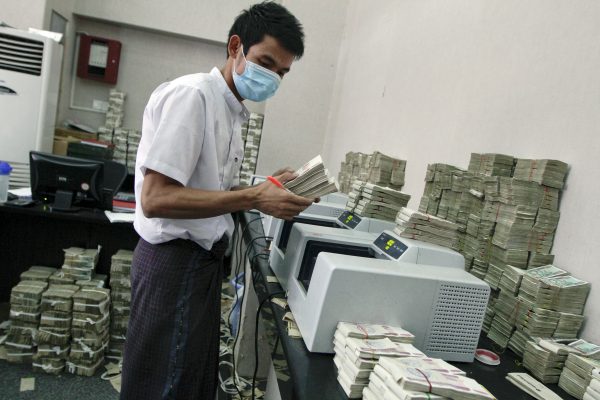In this week’s lead essay, Adam Triggs explores how Asia’s developing countries are paying for the COVID-19 pandemic. The results expose a stark divide across the region. While Asia’s developed countries are relying entirely on their central banks and finance ministries, Asia’s developing countries are, on average, relying on multilateral bodies and bilateral aid for almost 50 per cent of their financing of the economic fallout they face.
Where is this money coming from? Triggs finds that more than half of the external assistance to Asia’s developing countries ‘is coming from the Asian Development Bank, 20 per cent from the World Bank, 10 per cent from the Asian Infrastructure Investment Bank, 8 per cent from the IMF, and 5 per cent from bilateral aid (predominantly from the United States, Japan and Australia). The remainder is coming primarily from the Islamic Development Bank and the United Nations’.
These findings have big implications for Asia, not just for how to beat COVID-19 and strengthen the post-COVID-19 recovery, but also in how these financial developments are shaping Asia’s geopolitics.
The findings underscore the critical importance of multilateral and bilateral finance in beating the health and economic consequences of COVID-19. Any deficiencies in this external assistance translate directly into a less effective response to the health and economic impacts of COVID-19. Ultimately, in a highly interconnected region, this puts all countries at risk, developed and developing alike.
Developing countries have little option but to rely on external finance given their limited fiscal and monetary policy space. ‘Shallow and inefficient financial markets make monetary policy less effective’, notes Triggs, while ‘porous tax systems, foreign denominated debt and flighty foreign investors reduce fiscal firepower’. But the choice of where Asia’s economies are seeking assistance is just as telling.
Less than 8 per cent of assistance has come from the IMF — far lower than the support provided to other regions during the pandemic. The anti-IMF stigma in Asia is as strong as ever. Asia’s regional alternative — the Chiang Mai Initiative Multilaterlization — doesn’t offer a much better alternative. Despite facing the biggest downturn since the Great Depression, the CMIM is yet to have a single customer in its ten years of existence. ‘This confirms the concerns of many that the CMIM is unworkable’, says Triggs.
Behind all these decisions are big implications for Asia’s geopolitics. Asia’s developing countries have a preference for renminbi over dollars when it comes to getting financial support for COVID-19.
Triggs shows that the US-dominated IMF is being shunned in favour of the China-dominated Asian Infrastructure Investment Bank. The same is true for bilateral currency swap lines — where a central bank can swap its currency with that from another central bank to get much needed foreign exchange during times of stress. While the US Federal Reserve has shunned Asia’s developing economies by refusing to extend swap lines to them — a strategically foolish move — the People’s Bank of China has been happy to fill the gap.
Laos could be a test case. Laos is staring down a full-scale sovereign default as the combination of rising foreign denominated debts, a falling exchange rate, declining foreign exchange reserves and big repayments start to bite.
Much of Laos’ debt is with China. Will China bail out Laos through a bilateral swap line? Will China forgive its debts? What does this mean for the lending to Laos that has already taken place through the ADB, World Bank and the United Nations? And given the United States, Japan, Germany and others have already lent or given aid to Laos, what will they do in response?
Like an earthquake hitting buildings, COVID-19 has revealed the fault lines in economies and health systems around the world. It has also revealed the fault lines in Asia’s financial architecture. Improving access to external finance will require reforms at the global, regional and bilateral level, as Triggs argues.
As ever, the outcome of the US election will be key. ‘Asia’s response to COVID-19 should be wake-up call to Washington’, says Triggs. ‘Making the IMF relevant to Asia means ensuring Asia is represented in the IMF’s governance’.
President Trump’s deepening ‘America First’ rhetoric suggests little change from a re-elected Trump administration in its approach to international institutions. But an incoming Biden administration provides an opportunity for substantive IMF and World Bank reform to strengthen the role of Asia (including India) in those institutions, deflect regional alternatives and increase US-clout in the process.
‘But if the IMF can’t be made more inclusive of Asia’, notes Triggs, ‘the CMIM needs to be a credible alternative’. COVID-19 has revealed the CMIM as a still ineffective institution. Funding amounts are too low, the application process is too complicated and politicised, and any borrowing over 40 per cent of the country’s quota requires an IMF program anyway. The CMIM will not be a credible alternative until these problems are addressed.
None of these challenges — whether they relate to global institutions or regional bodies — can be addressed quickly. Given COVID-19 isn’t waiting, short-term measures will be required. This means a greater reliance on bilateral solutions to fill the gap. Asia’s developed economies need to clarify and expand their currency swap lines — clarify that they are available to countries facing balance of payments difficulties and expand them to the countries which are falling through the cracks —and be prepared to work cooperatively with China in filling the regional financial gap.
The fact is that the financial support from swap lines, bilateral loans and multilateral institutions has geopolitical implications and a big impact on how quickly and effectively Asia will defeat COVID-19. The faster we appreciate this, the better.
The EAF Editorial Board is located in the Crawford School of Public Policy, College of Asia and the Pacific, The Australian National University.
This article is part of an EAF special feature series on the novel coronavirus crisis and its impact.

